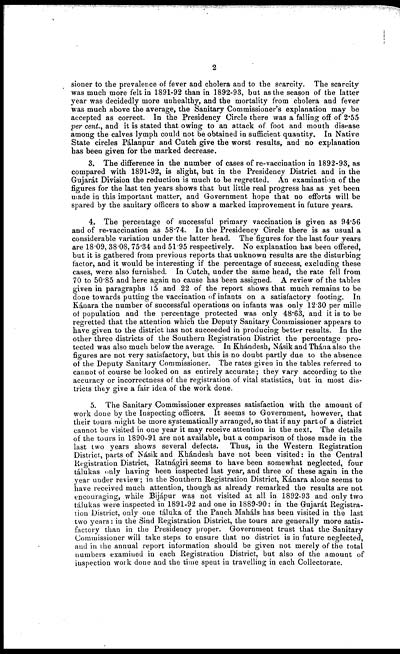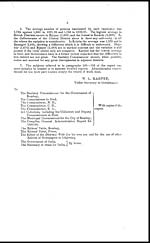Medicine - Vaccination > 1899-1928 - Report on vaccination in the Bombay Presidency > Vaccination in Bombay 1889-1901 > 1892-1893 - Report on vaccination in the Bombay Presidency, for the year 1892-93
(198) Page 2
Download files
Individual page:
Thumbnail gallery: Grid view | List view

2
sioner to the prevalence of fever and cholera and to the scarcity. The scarcity
was much more felt in 1891-92 than in 1892-93, but as the season of the latter
year was decidedly more unhealthy, and the mortality from cholera and fever
was much above the average, the Sanitary Commissioner's explanation may be
accepted as correct. In the Presidency Circle there was a falling off of 2.55
per cent., and it is stated that owing to an attack of foot and mouth disease
among the calves lymph could not be obtained in sufficient quantity. In Native
State circles Pálanpur and Cutch give the worst results, and no explanation
has been given for the marked decrease.
3. The difference in the number of cases of re-vaccination in 1892-93, as
compared with 1891-92, is slight, but in the Presidency District and in the
Gujarát Division the reduction is much to be regretted. An examination of the
figures for the last ten years shows that but little real progress has as yet been
made in this important matter, and Government hope that no efforts will be
spared by the sanitary officers to show a marked improvement in future years.
4. The percentage of successful primary vaccination is given as 94.56
and of re-vaccination as 58.74. In the Presidency Circle there is as usual a
considerable variation under the latter head. The figures for the last four years
are 18.09, 38.08, 75.34 and 51.95 respectively. No explanation has been offered,
but it is gathered from previous reports that unknown results are the disturbing
factor, and it would be interesting if the percentage of success, excluding these
cases, were also furnished. In Cutch, under the same head, the rate fell from
70 to 50.85 and here again no cause has been assigned. A review of the tables
given in paragraphs 15 and 22 of the report shows that much remains to be
done towards putting the vaccination of infants on a satisfactory footing. In
Kánara the number of successful operations on infants was only 12.30 per mille
of population and the percentage protected was only 48.63, and it is to be
regretted that the attention which the Deputy Sanitary Commissioner appears to
have given to the district has not succeeded in producing better results. In the
other three districts of the Southern Registration District the percentage pro-
tected was also much below the average. In Khándesh, Násik and Thána also the
figures are not very satisfactory, but this is no doubt partly due to the absence
of the Deputy Sanitary Commissioner. The rates given in the tables referred to
cannot of course be looked on as entirely accurate; they vary according to the
accuracy or incorrectness of the registration of vital statistics, but in most dis-
tricts they give a fair idea of the work done.
5. The Sanitary Commissioner expresses satisfaction with the amount of
work done by the Inspecting officers. It seems to Government, however, that
their tours might be more systematically arranged, so that if any part of a district
cannot be visited in one year it may receive attention in the next. The details
of the tours in 1890-91 are not available, but a comparison of those made in the
last two years shows several defects. Thus, in the Western Registration
District, parts of Násik and Khándesh have not been visited: in the Central
Registration District, Ratnágiri seems to have been somewhat neglected, four
tálukas only having been inspected last year, and three of these again in the
year under review; in the Southern Registration District, Kánara alone seems to
have received much attention, though as already remarked the results are not
encouraging, while Bijápur was not visited at all in 1892-93 and only two
tálukas were inspected in 1891-92 and one in 1889-90: in the Gujarát Registra-
tion District, only one táluka of the Panch Maháls has been visited in the last
two years: in the Sind Registration District, the tours are generally more satis-
factory than in the Presidency proper. Government trust that the Sanitary
Commissioner will take steps to ensure that no district is in future neglected,
and in the annual report information should be given not merely of the total
numbers examined in each Registration District, but also of the amount of
inspection work done and the time spent in travelling in each Collectorate.
Set display mode to: Large image | Zoom image | Transcription
Images and transcriptions on this page, including medium image downloads, may be used under the Creative Commons Attribution 4.0 International Licence unless otherwise stated. ![]()
| Permanent URL | https://digital.nls.uk/91030045 |
|---|
| Attribution and copyright: |
|
|---|



![[Page 1]](https://deriv.nls.uk/dcn4/9103/91030044.4.jpg)
